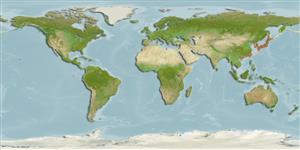Corbicula japonica Prime, 1864
Japanese Corbicula| Native range | All suitable habitat | Point map | Year 2050 |

|
| This map was computer-generated and has not yet been reviewed. |
| Corbicula japonica AquaMaps Data sources: GBIF OBIS |
Google image | No image available for this species;
drawing shows typical species in Cyrenidae.
Classification / Names Common names | Synonyms | CoL | ITIS | WoRMS
Bivalvia | Venerida | Cyrenidae
Environment: milieu / climate zone / depth range / distribution range Ecology
Benthic; brackish; depth range 0 - 6 m (Ref. 385). Subtropical
Distribution Countries | FAO areas | Ecosystems | Occurrences | Introductions
Northwest Pacific: from south of Japan to the south of Sakhalin.
Length at first maturity / Size / Weight / Age
Maturity: Lm ?, range 2 - ? cm Max length : 4.0 cm SHL male/unsexed; (Ref. 127304); max. reported age: 10 years (Ref. 127304)
Life cycle and mating behavior Maturity | Reproduction | Spawning | Eggs | Fecundity | Larvae
Main reference
References | Coordinator | Collaborators
SAUP Database 2006 SAUP Database. www.seaaroundus.org. (Ref. 356)
IUCN Red List Status
(Ref. 130435: Version 2025-1)
CITES status (Ref. 108899)
CMS (Ref. 116361)
Threat to humans
Human uses
Fisheries: commercial
FAO - Fisheries: landings, species profile | FishSource | Sea Around Us
Tools
More information
Max. ages / sizes
Length-weight rel.
Length-length rel.
Length-frequencies
Mass conversion
Abundance
Internet sources
BHL | BOLD Systems | CISTI | DiscoverLife | FAO(Fisheries: species profile; publication : search) | Fishipedia | GenBank (genome, nucleotide) | GloBI | Gomexsi | Google Books | Google Scholar | Google | PubMed | Tree of Life | Wikipedia (Go, Search) | Zoological Record



